
Just after the Christmas holiday my husband and I flew down to Baja California, Sur. We were heading there to attend our friend’s wedding vow renewal ceremony and celebrate with them. I had never been on “that side” of Mexico before and thought it was the perfect opportunity to squeeze in two days of fishing. Trips to Mexico translate to mean bone and permit fishing to me, but this new destination would provide an opportunity to target a new species – roosterfish.
I didn’t know a lot about roosterfish other than they could be caught on a fly, could get pretty big (commonly up to 20lbs but can grow to over 100lbs), and were a really cool looking fish with their distinct comb dorsal fins. I also knew they had a reputation of being aggressive predators that ambush prey with rapid speed. While my fish biology knowledge is limited, my understanding is that roosterfish are part of the jack family, which would explain their predatory style, aggression and speed. And I’m a big fan of jacks. They are incredible fighters and a feat to land. With a great deal of excitement, I reached out to Juan Lucero who, I was told, was the fly-fishing guide in that area to go rooster fishing with. Done.
I packed light. It was a casual affair. Shorts, a sundress, both my Winston Air Max 2 9wt and 10wt, and my Hardy Zan Pro 11wt. Of course, I also included a Zen Kyojin II with a few Zen Fusion Big Lines in the 16ft and 28ft lengths. I had no idea what I was getting into but if I had a shot at landing a roosterfish on tenkara, I wanted to be prepared and knew the Kyojin was the tenkara rod that could do it.
I was told to bring down sardine fly patterns and an intermediate sinking line. Believe it or not, on saltwater trips that potentially include tenkara, I often bring a short section of 8wt fast sinking or intermediate sinking line to use on my tenkara setup. In a few scenarios I’ve attached it to my floating Fusion Line to get my fly down a litter faster. Sometimes I only use about a 3-foot section. Even this short piece can be very helpful in getting the fly down quickly. Since your “stripping” area or distance is shorter when using a tenkara rod, often time is of the essence. Particularly when casting in deeper water, getting your fly to where the fish are, is critical. A perfect example of this is with mudding bonefish. A short section of sinking line can be highly effective in this scenario while still keeping your tenkara setup nice and light.

On the day we arrived we had just enough time to get checked into our hotel, cleaned up and join our friends for some pre-ceremony celebrating that involved great food and a cautiously limited amount of tequila. We had to be on the road by 5am the next morning for an hour and half drive north to Ensenada Muertos, where we would meet our guide, Juan David. What we encountered that morning was a whole different scene from any other I had had so far.
Trucks hauling boats were stacked up in line. Drivers quickly maneuvered their trailers and dropped their boats into the water from the loading ramp. People moved quickly and efficiently and there was an air of excitement and joviality that was uplifting. So was the early morning temperatures which hovered around 45 degrees. I piled on all the layers I had brought and paced in my flip flops trying to get warm. The wind and moisture added to the chill. I was surprised that anywhere in Mexico could get this frigid. I needed to start casting to get warm.
We motored away from the ramp, set up rods and started to take off down the coastline when we suddenly slowed and another boat approached, mooring up beside us. Juan David greeted the two men while one of them began to quickly scoop live bait fish into a bucket and hand it over to Juan David. The mid-section of their boat was a quarter way filled with water and live fish sloshing around. Juan David emptied them into a storage tank in the bow hull of our boat. He asked us to pay the bait boat, which we did, then we quickly took off again. As we headed out, I continued to watch the other boat. The guys zoomed from one guide boat to another, scooping bucketfuls of bait that they had netted early that morning and selling them to guides and anglers. Bait? This was new to me for sure and I was getting really curious about the day.
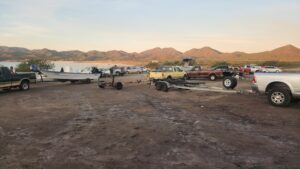

After a short ride Juan David slowed the boat, turned off the motor, stood on the bow and began tossing scoopfuls of bait fish into the water using a modified gallon jug. He instructed my husband and I to start casting. Cast far he told us, in the same direction as he threw the bait. Then strip through the bait as fast as you can. By the time he had thrown the second or third scoop of bait, we spotted busts in the water that signaled roosters. We now knew they were there.
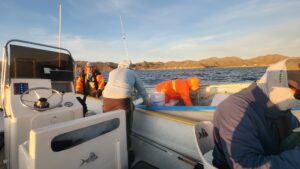
Initially I stripped with one hand. I got a few light bumps but nothing I was able to set the hook on. The faster I stripped the better the bump. I am new to two-handed stripping but decided now was the perfect time to initiate myself to the method. Getting the rod placed securely and comfortably under my right arm and against my body took some experimenting and getting used to, but eventually, it began to feel more natural. It made a difference. I missed the first hook set while things still felt awkward, but I set hard on the next bump, landing my first roosterfish.
The day was great. It reminded me of fishing for large lake trout on the Naknek river in Alaska when they would come downstream and feed furiously on smelt, creating huge busts on the surface of the water. Standing poised on the boat, we were ready to cast in any direction while trying to anticipate where the next surface explosion would occur. This was thrilling in an adrenaline-surging sort of way. Juan David would pause then throw another scoop or two of bait into the water.
I landed several roosterfish. All were in the 4-10lb range. Nothing huge but still exciting. Seeing them flash or their wild dorsal fin break the surface made my heart pound. I’ll confess, I had a weird feeling about using bait. It felt a little like I was cheating but our guide reminded us that we were in deep water, sometimes 70 meters. We had to bring the fish up to the surface somehow and we did that with bait. It made sense. Regardless, it was still a workout casting as far as possible and stripping as fast as possible during bursts of feeding craziness.
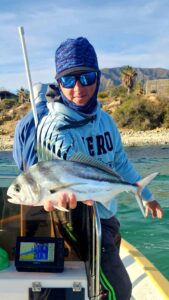

Once hooked the roosters ran but certainly not like a bonefish. They jumped too, but again, not like a tarpon. They fought, pulled and fussed but were kept under control with relative ease. Again, I never hooked a monster and size makes a difference. But then again, any fish that weighs 20lbs and up is a handful on a fly rod. Get into 40 or 50lbs and you can begin to wonder if you have the strength to finish the fight. That’s exactly how I started to feel when I hooked into a skipjack.
Blow my mind! What was on the end of my line? I set on a terrifically aggressive hit and was into my backing almost immediately. My reel was screaming, and I stayed clear of the crank. Finally, and well into my backing, I felt the first pause, but reeling was still impossible. Another run and further into my backing we went. This was reminiscent of a GT fight. After a truly epic battle and my arm nearly reaching a point of exhaustion, I finally brought the fish in. A skipjack tuna.
Torpedo-shaped with a forked tail this fast-swimming fish has the “highest percentage of skeletal muscle devoted to locomotion of all animals, at 68% of the animal’s total body mass”. Which is why this thing felt like a bullet train on my flyrod. It was spectacular and my arm was screaming as much as the reel. Two new species landed.

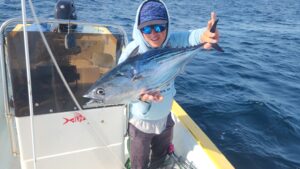
The next day we went out I hooked into another beefy fish. Again, Juan David baited the water while my husband and I started casting. By now the two-handed strip felt comfortable to me and I was feeling fairly proficient at it. We saw a break in the water and the bright neon green that told us it was not a rooster but a dorado. Letting the excitement get to me I cast but was about 12ft to the right of my target. Feeling a little frustrated with myself for letting that excitement get the better of me, I stripped in as fast as possible hoping for another opportunity and better placement of my fly when I got the hit. BOOM! I was on again. We were in very deep water and the fish not only ran, but it ran down, deep. The fight was thrilling but not near the battle of the skipjack. Once landed the mahi was larger than the tuna but softer and much less dense. The Skipjack weighed at least twice the mahi and felt stiff and like solid cement in my hands while my fingers sunk slightly into the softer flesh of the mahi. The difference between the two fish were astonishing. Another species added to the list.


Feeling very satisfied I contemplated my tenkara rod. I had the line and could quickly set it up. A whale surfaced about 1000ft away from us. Juan David said it was a blue whale. It was an incredible sight. We actually saw whales both days we fished. That reminded me of how deep the water was we were in. I looked at my tenkara rod and decided to leave it in its case.
While I definitely could land the roosterfish I caught on my fly rod, on my Kyojin Tenkara rod, the water was very deep and the bow area, especially with the bait tank, limited. This was not the right scenario. I felt confident that if surfcasting from the beach, I could land a roosterfish fairly quickly. The morning we were scheduled to depart for home, I walked down to the water’s edge by my hotel. I saw roosters feeding in the early morning light. They were in close, and I knew I could reach them with my 28ft Fusion Line. My gear was already packed and my husband reminded me we had an hour drive to the airport and a rental car to return. I looked out at the busts of feeding fish and knew I had to come back and try.
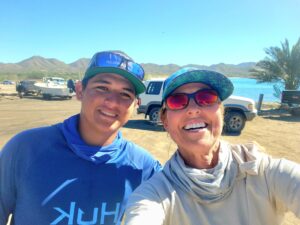




What an awesome couple days of fishing!!
It really was! (And I so hope to do it again). Fingers crossed.